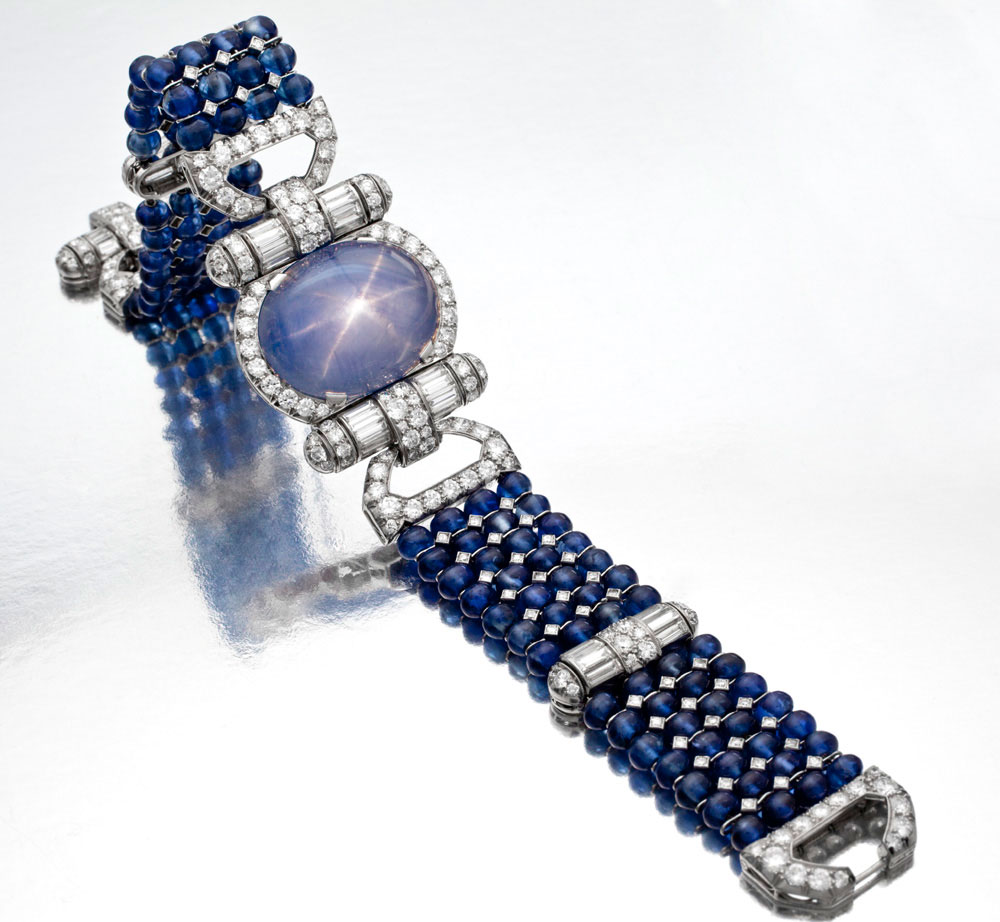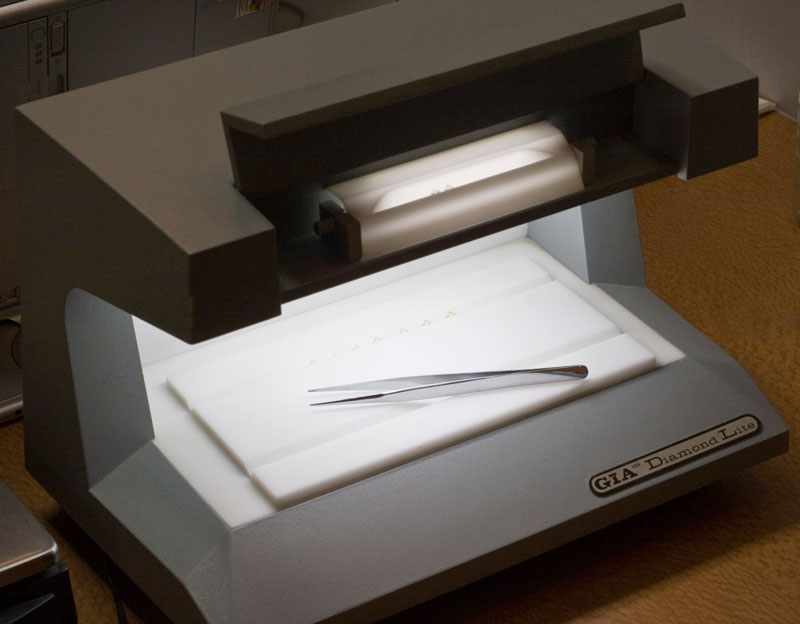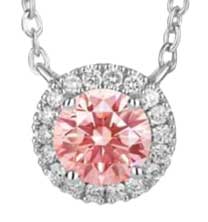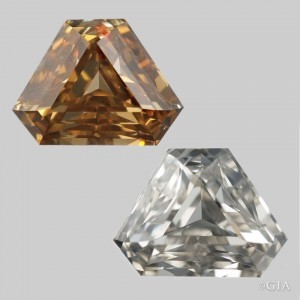Exploring the 4 Cs:
Color - more complex than you may think
 The 4 Cs help determine the value of all gemstones, but the importance of each "C" can be different for different stones. This issue looks at Color in colored gems, particularly emerald, ruby and sapphire, and in diamond.
The 4 Cs help determine the value of all gemstones, but the importance of each "C" can be different for different stones. This issue looks at Color in colored gems, particularly emerald, ruby and sapphire, and in diamond.
 The 4 Cs help determine the value of all gemstones, but the importance of each "C" can be different for different stones. This issue looks at Color in colored gems, particularly emerald, ruby and sapphire, and in diamond.
The 4 Cs help determine the value of all gemstones, but the importance of each "C" can be different for different stones. This issue looks at Color in colored gems, particularly emerald, ruby and sapphire, and in diamond. Color may seem like the simplest, the most obvious, the most recognizable of the 4 Cs. But in the gemological world, and in gemological description, it can be surprisingly intricate and fascinating.
Color description
For colored gemstones, color is the most important determinant of value.
That may seem obvious, but describing color accurately can be a tricky business. In the past, the most appealing sapphire color was often described on appraisals as "cornflower blue." But in the picture of cornflowers here, which color is "cornflower blue?"
Similarly, "pigeon blood" is a traditional term for a highly prized ruby color. You may still encounter this on appraisals but the term can be used too loosely, applied to stones not even close to the appropriate color range. For quality ruby, even slight variations in color can mean significant differences in valuation, so metaphoric or poetic terms are not acceptable color descriptions.
On the other extreme, insurers often see appraisals with an emerald described as green, a sapphire as blue, a ruby as red. These are hardly sufficient if there is a loss and the insured expects a replacement that looks like the original.
GIA created a consistent and systematic way to communicate the color of faceted transparent gems. Basing its system on Munsell, GIA's system describes color in terms of tone, saturation and hue.
In that grading system, a ruby might be described something like this:
medium dark (tone), vivid (saturation) purplish red (hue)
Any special characteristics of the stone, such as asterism in this bracelet's remarkable sapphire, should be described on the appraisal and lab report.
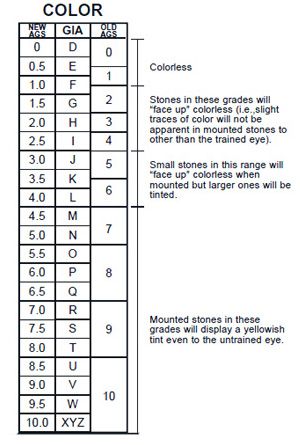 For diamond — the "colorless" diamond so popular in jewelry — color is a different story.
For diamond — the "colorless" diamond so popular in jewelry — color is a different story.
Here we are interested not in describing color but in grading the lack of color.
GIA's Color Grading Scale—center column in the graphic—is the most widely used system. Of all diamonds mined, only about 1% are of the highest grades, D and E. The rest have some cast of yellow or tan, which lowers their value, or have other characteristics that make them unsuitable for jewelry.
To grade a diamond's color, the appraiser uses a set of 9 master stones, which are diamonds in color gradations labeled to correspond to the GIA color grades. The appraiser matches the subject diamond to one in the set.
A diamond light box creates a standard environment for grading: it simulates ideal daylight and reduces glare and reflection from colors in the room, creating optimal conditions for comparing a diamond with the master set of graded stones.

|
Given the high valuation of diamond, a difference of one color grade can mean thousands of dollars, so the accuracy of the master set, consistency of lighting, and the care and expertise of the appraiser are all crucial.
Fancies. Mined diamonds of saturated color, known as fancies, are extremely rare and stratospheric in valuation. We're usually only aware of them when a celebrity buys some stunning and pricey piece of jewelry or a spectacular gem is sold at auction.
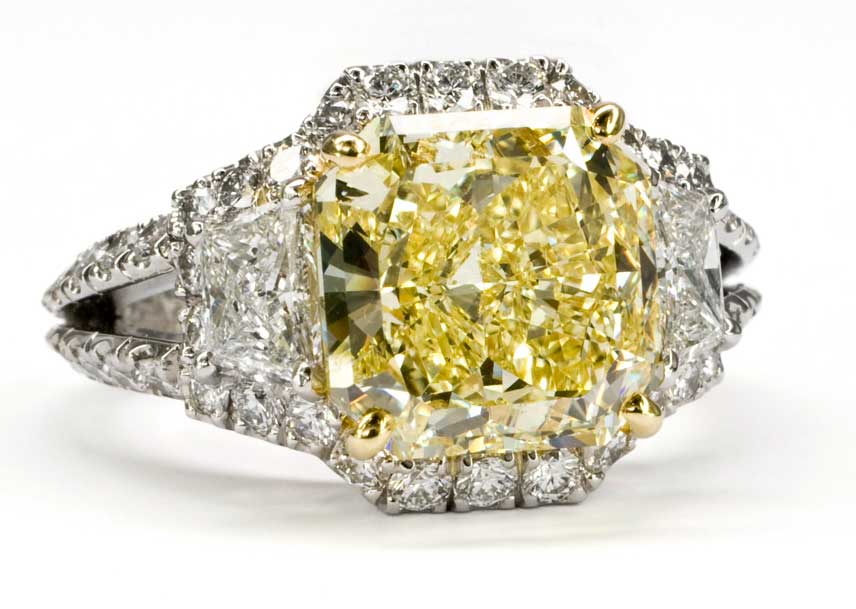
|
Pendant with Lab-Grown diamonds |
Lab-grown diamonds with saturated color are far more affordable. DeBeers' Lightbox line, which began selling blue and pink lab-grown diamond for $800 per carat in 2018, not only disrupted pricing for lab-made diamond, but also impacted the mined diamond market. As technology improves, more gem-growers are entering the market, and more lab-made gems may try to pass as mined.
Given the great valuation difference between mined diamond and lab-grown, it is increasingly important for insurance appraisals to state whether the diamonds are mined or lab-grown.
Color Treatments
A color treatment, or enhancement, is done to improve a gem's color, making the gem more attractive and more salable. Enhancements are done to both diamonds and colored gems. And they are done to both mined and lab-made stones.
Color treatments can remarkably transform a gem's appearance, as shown in this picture of a brown diamond before and after High Pressure-High Temperature treatment.
All treatments should be noted on the appraisal, because a treated gem has a lower valuation than an untreated gem of the same appearance.
Sapphires and rubies are usually heat-treated to enhance the gem's color and clarity. Heating should be mentioned on the appraisal, but even if no mention is made, it is assumed sapphire and ruby have been heat-treated unless otherwise specified. This treatment is permanent and will not degrade over time.
Note: A sapphire that is not heat treated is extremely rare. Unheated mined sapphires may sell for 4 or more times the price of a heat-treated sapphire of similar appearance, so lack of heat treatment should be specifically stated on the appraisal.
Other color treatments, such as oiling, dyeing or waxing, are not considered permanent and they lower the value of the gem. They should be mentioned on the appraisal.
Some gems are treated not only to improve their color but to totally change their color. For example, an off-color diamond, one that is yellowish or brownish, can be treated so it takes on a strong color, like blue or green—meaning it might be passed and priced as a fancy.
Natural fancies have a MUCH higher value than color-enhanced diamonds. Without disclosure, an enhanced diamond could be sold—and priced—as a natural fancy.
Detection of color treatments may require testing with instruments beyond what would be found in the average jeweler's lab. For high-value diamonds, always get a report from a reliable lab (see links below).
Provenance
As most colored gems are forming in the earth's crust, they encounter other elements that affect their color. Inclusions of foreign material also help gemologists determine the gem's geographic origin. Rubies from Burma and sapphires from Kashmir and Sri Lanka (Ceylon) fetch some of the highest prices because of their superior hue, saturation and clarity.
However, geographic provenance alone does not determine value, since every mine produces a wide range of quality. The origin must be documented by a reliable lab, such as GIA, AGL, or Güblin. (See links below.)
For diamond, the geographic location of the mine is not relevant to valuation or quality. Diamond's origin is deep in the earth's mantle, about 100 miles below the surface, where it formed under conditions of high temperature and high pressure at least a billion years ago. Diamond was completely formed by the time some violent eruption brought it close enough to the earth's surface to be mined, so elements it encountered along the way have no effect on its color.
Color's role in fraud
- Lack of disclosure
Color-treated diamonds are worth significantly less than untreated diamonds of similar appearance. This is especially important with fancies. Without disclosure and appropriate pricing, the insured would pay more for the purchase, insurance premiums would be unnecessarily high and, in the event of a loss, a settlement could result in gross overpayment.
- Look-alikes
Sapphire is a fairly pricey gem, but there are other blue gems. A potential buyer can be told the stone in the ring is sapphire, but it might be a less expensive stone, such as tanzanite or aquamarine or spinel.
One unusual scam involved a diamond ring in which two stones thought to be diamonds turned out to be diamond-coated moissanite, an inexpensive lab-made stone. The ruse was only discovered when the insurer, in the process of settling a claim, sent the stones to GIA for lab reports.
- Imitations
 Padparadscha is a rare and valuable pink-orange corundum originally mined in Ceylon (Sri Lanka). In 2001 padparadscha-like sapphires, supposedly from East Africa, began appearing in the market. Dealers suspected a new treatment, done especially to mimic the rare gem, but the treatment was difficult to detect. Ultimately, thousands of the treated stones were sold—without disclosure. They were worth only a fraction of the value they were given.
Padparadscha is a rare and valuable pink-orange corundum originally mined in Ceylon (Sri Lanka). In 2001 padparadscha-like sapphires, supposedly from East Africa, began appearing in the market. Dealers suspected a new treatment, done especially to mimic the rare gem, but the treatment was difficult to detect. Ultimately, thousands of the treated stones were sold—without disclosure. They were worth only a fraction of the value they were given.
- Non-permanent treatments
Color treatments such as oiling, dyeing, coating or waxing will degrade over time—and customers should be warned of this at time of purchase. Failure of a treatment is not damage for which the insurer is liable.
- Flexible grading
The mineral corundum appears in a wide range of colors—red, green, yellow, purple, etc.. The red stones are called ruby and all the other colors are sapphire, but the gem ruby commands a higher valuation than sapphire. At what point does ruby become pink sapphire? The appraiser who makes that call must be well trained, have a discriminating eye, be familiar with colored gemstones, and be reliable.
- Renaming the gem
One woman bought an emerald ring on vacation. When she got home and had it appraised, the appraiser said it did not meet the U.S. standards to be called emerald. It was probably beryl, a common mineral which is found around the world and appears in a variety of colors, including green.
 Selections of green beryl
Selections of green beryl
Emerald is a recognized member of the big four (with diamond, ruby and sapphire) and it gets consumer respect. So: green beryl is marketed as emerald, yellow beryl is marketed as yellow emerald, red beryl is marketed as red emerald.
Color-treated diamonds are worth significantly less than untreated diamonds of similar appearance. This is especially important with fancies. Without disclosure and appropriate pricing, the insured would pay more for the purchase, insurance premiums would be unnecessarily high and, in the event of a loss, a settlement could result in gross overpayment.
Sapphire is a fairly pricey gem, but there are other blue gems. A potential buyer can be told the stone in the ring is sapphire, but it might be a less expensive stone, such as tanzanite or aquamarine or spinel.
One unusual scam involved a diamond ring in which two stones thought to be diamonds turned out to be diamond-coated moissanite, an inexpensive lab-made stone. The ruse was only discovered when the insurer, in the process of settling a claim, sent the stones to GIA for lab reports.
 Padparadscha is a rare and valuable pink-orange corundum originally mined in Ceylon (Sri Lanka). In 2001 padparadscha-like sapphires, supposedly from East Africa, began appearing in the market. Dealers suspected a new treatment, done especially to mimic the rare gem, but the treatment was difficult to detect. Ultimately, thousands of the treated stones were sold—without disclosure. They were worth only a fraction of the value they were given.
Padparadscha is a rare and valuable pink-orange corundum originally mined in Ceylon (Sri Lanka). In 2001 padparadscha-like sapphires, supposedly from East Africa, began appearing in the market. Dealers suspected a new treatment, done especially to mimic the rare gem, but the treatment was difficult to detect. Ultimately, thousands of the treated stones were sold—without disclosure. They were worth only a fraction of the value they were given.
Color treatments such as oiling, dyeing, coating or waxing will degrade over time—and customers should be warned of this at time of purchase. Failure of a treatment is not damage for which the insurer is liable.
The mineral corundum appears in a wide range of colors—red, green, yellow, purple, etc.. The red stones are called ruby and all the other colors are sapphire, but the gem ruby commands a higher valuation than sapphire. At what point does ruby become pink sapphire? The appraiser who makes that call must be well trained, have a discriminating eye, be familiar with colored gemstones, and be reliable.
One woman bought an emerald ring on vacation. When she got home and had it appraised, the appraiser said it did not meet the U.S. standards to be called emerald. It was probably beryl, a common mineral which is found around the world and appears in a variety of colors, including green.
 Selections of green beryl
Selections of green berylEmerald is a recognized member of the big four (with diamond, ruby and sapphire) and it gets consumer respect. So: green beryl is marketed as emerald, yellow beryl is marketed as yellow emerald, red beryl is marketed as red emerald.
The best hedge against all kinds of fraud is a detailed appraisal from a reliable appraiser independent of the seller, and a lab report from a reliable lab. See below for links.
Note: Vacationers are an easy mark for gem scams. Be wary of insuring gems or jewelry bought on holiday in tourist areas. Insist on detailed and reliable JISO 78/79 appraisals.
FOR AGENTS & UNDERWRITERS
For sapphires and other colored gems, color is the main determinant of value. The appraisal should describe the gem's color in terms of tone, saturation and hue. A vague description, such as "blue sapphire," is useless.
High-value Kashmir, Burma and Ceylon rubies and sapphires should be accompanied by a report from a reliable lab (such as AGL or Gübelin) verifying origin. (The insured can take the jewelry to their own jeweler, who will send it to a lab that has the equipment and expertise to determine gem origin.)
The appraisal should state that the gem is either mined (sometimes called natural) or lab-grown (formerly sometimes called synthetic). Lab-made diamond has a far lower valuation than mined diamond, so be sure the appraisal specifies which it is. You don't want to replace a lab-made stone with a higher-value mined stone after a claim.
For colored gems, it is essential that the appraisal be written by a gemologist experienced with colored stones and familiar with the current pricing, treatments and frauds. Most jewelers deal primarily with diamonds, and even a trained gemologist may have little experience with colored stones.
All scheduled diamonds of one carat or more should have a lab report from a reputable gem-grading lab.
Reputable labs for verifying reports you receive:
GCAL
Gubelin
GIA
AGS
AGL (Call to verify AGL report.)
A lab report or certificate is not a substitute for an appraisal. A lab report or certificate describes only the gem, not the jewelry, and it does not—and should not—give valuation. (If it does, it is a sales tool, not a disinterested description of the gem's qualities.)
The best appraisal includes the JISO 78/79 appraisal form and is written by a qualified gemologist (GG, FGA+, or equivalent), preferably one who has additional insurance appraisal training. One course offering such additional training is the Certified Insurance Appraiser™ (CIA) course of the Jewelry Insurance Appraisal Institute.
FOR ADJUSTERS
While there are fewer claims on colored gems than on diamonds, colored stones usually have much higher markups and generally have inflated valuations. Most consumers are totally unfamiliar with colored stones, and the pricing abuses are great.
Compare the sales receipt with the appraisal. If there is a great discrepancy between selling price and valuation, the selling price probably reflects value more accurately.
If the sale price seems too low for the appraised value, it's possible that the gem was lab-grown or had an undisclosed color treatment, or that the stone is a lower-value substitute, such as spinel passed off as ruby.
Check all documents for mention of treatments or enhancements. Enhanced gems have a significantly lower value than untreated gems of similar appearance.
©2000-2024, JCRS Inland Marine Solutions, Inc. All Rights Reserved. www.jcrs.com

